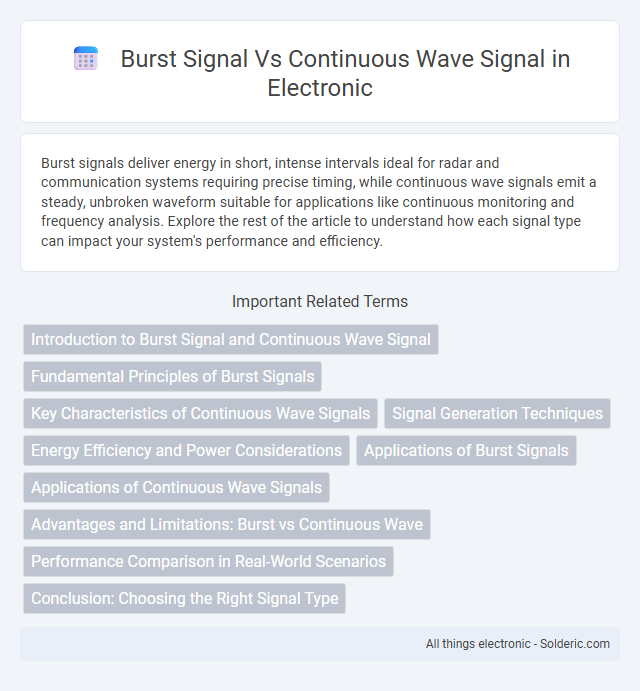Burst signals deliver energy in short, intense intervals ideal for radar and communication systems requiring precise timing, while continuous wave signals emit a steady, unbroken waveform suitable for applications like continuous monitoring and frequency analysis. Explore the rest of the article to understand how each signal type can impact your system's performance and efficiency.
Comparison Table
| Feature | Burst Signal | Continuous Wave Signal |
|---|---|---|
| Definition | Short, intermittent waveform packets | Uninterrupted, steady waveform |
| Duration | Finite bursts, time-limited | Infinite or long duration |
| Frequency | Fixed frequency within bursts | Constant single frequency |
| Applications | Radar pulses, digital communication | Continuous communication, CW radar |
| Energy Distribution | Energy concentrated in bursts | Energy evenly distributed over time |
| Bandwidth | Broader due to burst modulation | Narrow, single frequency |
| Signal Detection | Time-gated detection required | Continuous detection possible |
| Interference | Less susceptible due to time gaps | More prone to continuous interference |
Introduction to Burst Signal and Continuous Wave Signal
Burst signals consist of a series of pulses separated by intervals of no transmission, enabling efficient energy usage and reducing interference in radar and communication systems. Continuous wave (CW) signals maintain a constant amplitude and frequency, providing stable and uninterrupted transmission, commonly used in applications requiring precise frequency measurement and Doppler radar. Understanding the distinct temporal characteristics and applications of burst and continuous wave signals is essential for optimizing system performance across various electronic and telecommunications fields.
Fundamental Principles of Burst Signals
Burst signals consist of short, timed intervals of wave energy separated by periods of inactivity, allowing efficient use of power and bandwidth in communication systems. Unlike continuous wave signals that maintain a constant amplitude and frequency, burst signals transmit data in packets, enhancing signal clarity and reducing interference. Your communication system benefits from burst signals by enabling precise timing control and improved synchronization in digital transmissions.
Key Characteristics of Continuous Wave Signals
Continuous wave signals maintain a constant amplitude and frequency, producing a steady, unmodulated waveform ideal for applications like radar and communications where consistent signal strength is crucial. These signals enable precise frequency analysis and are easier to generate and detect compared to burst signals, which transmit energy in short, intermittent pulses. Your system's performance benefits from continuous wave signals through improved signal stability and reduced complexity in signal processing.
Signal Generation Techniques
Burst signal generation involves producing short, discrete pulses with controlled amplitude, frequency, and phase, often using gated oscillators or pulse modulators for precise timing. Continuous wave (CW) signal generation relies on stable oscillators such as crystal or voltage-controlled oscillators (VCOs) to emit a constant frequency sine wave without interruption. Both techniques employ phase-locked loops (PLLs) to maintain signal stability and spectral purity, with burst signals requiring additional gating circuits to shape pulse duration and repetition rate.
Energy Efficiency and Power Considerations
Burst signals offer higher energy efficiency by transmitting power in short, intense pulses, reducing overall energy consumption compared to continuous wave signals that emit power steadily. Continuous wave signals maintain constant power output, leading to greater energy use over time but enabling consistent signal detection and simpler receiver design. Power considerations favor burst signals in applications requiring lower average power and longer battery life, while continuous waves suit scenarios demanding uninterrupted signal presence and stable power delivery.
Applications of Burst Signals
Burst signals find extensive applications in radar and communication systems where time-efficient data transmission and target detection are critical. They enable precise range measurement and object identification by transmitting short, high-energy pulses followed by listening intervals. Burst signals are also widely used in ultrasonic imaging and wireless sensor networks due to their ability to minimize interference and enhance signal resolution.
Applications of Continuous Wave Signals
Continuous wave (CW) signals are widely used in radar systems for speed detection, such as in police radar guns, due to their ability to measure Doppler shifts accurately. They also serve in communication systems, including radio and microwave transmissions, where stable frequency and phase enable efficient data transfer. Medical applications such as Doppler ultrasound employ CW signals to monitor blood flow by detecting frequency changes caused by motion.
Advantages and Limitations: Burst vs Continuous Wave
Burst signals offer advantages such as reduced power consumption and enhanced target resolution due to their pulsed nature, making them ideal for radar and communication systems requiring precise timing. Continuous wave signals provide constant transmission allowing for simpler detection and measurement of Doppler shifts, but they often consume more power and may suffer from reduced range resolution. Your choice between burst and continuous wave signals depends on the balance between power efficiency and the need for accurate distance or velocity measurement.
Performance Comparison in Real-World Scenarios
Burst signals offer superior performance in real-world scenarios requiring precise range measurement and target detection due to their high peak power and time-gated operation, which reduces interference and multipath effects. Continuous wave (CW) signals, while providing constant signal transmission and better Doppler resolution, often struggle with clutter and noise in dynamic environments, limiting their effectiveness in congested or reflective settings. The choice depends on application-specific factors, with burst signals excelling in radar and communication systems needing high accuracy and CW preferred in applications prioritizing velocity measurement and simplicity.
Conclusion: Choosing the Right Signal Type
Selecting the appropriate signal type depends on the specific application requirements such as range, resolution, and power efficiency. Burst signals excel in short-range, high-resolution radar and communication systems due to their high peak power and temporal localization. Continuous wave signals offer advantages in long-range detection and Doppler measurement, providing steady-state power and simpler signal processing.
Burst signal vs continuous wave signal Infographic

 solderic.com
solderic.com